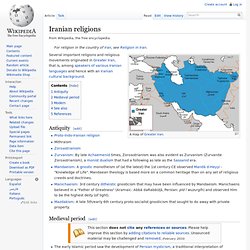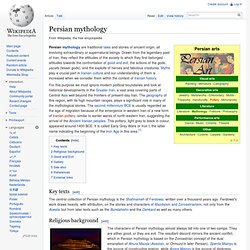

Iranian religions. Several important religions and religious movements originated in Greater Iran, that is, among speakers of various Iranian languages and hence with an Iranian cultural background.

Antiquity[edit] Proto-Indo-Iranian religionMithraismZoroastrianismZurvanism: By late Achaemenid times, Zoroastrianism was also evident as Zurvanism (Zurvanite Zoroastrianism), a monist dualism that had a following as late as the Sassanid era.Mandaeism: A gnostic monotheism of (at the latest) the 1st century CE observed Mandā d-Heyyi - "Knowledge of Life".
Mandaean theology is based more on a common heritage than on any set of religious creeds and doctrines.Manichaeism: 3rd century ditheistic gnosticism that may have been influenced by Mandaeism. Manichaens believed in a "Father of Greatness" (Aramaic: Abbā dəRabbūṯā, Persian: pīd ī wuzurgīh) and observed Him to be the highest deity (of light).Mazdakism: A late 5th/early 6th century proto-socialist gnosticism that sought to do away with private property. Persian mythology. Persian mythology are traditional tales and stories of ancient origin, all involving extraordinary or supernatural beings.

Scythian religion. A collection of drawings of Scythian stelae, ranging from ca. 600 BC to AD 300.

Many of them depict warriors, apparently representing the deceased buried in the kurgan, holding a drinking horn in their right hand. Scythian religion refers to the mythology, ritual practices and beliefs of the Scythians, an ancient Iranian people who dominated Central Asia and the Pontic-Caspian steppe in Eastern Europe throughout Classical Antiquity. What little is known of the religion is drawn from the work of the 5th century Greek historian and ethnographer Herodotus.
Scythian religion is assumed to have been related to the earlier Proto-Indo-Iranian religion, and to have influenced later Slavic, Hungarian and Turkic mythologies, as well as some contemporary Eastern Iranian and Ossetian traditions. Archaeological context[edit] The primary archaeological context of horse sacrifice are burials, notably chariot burials, but graves with horse remains reach from the Eneolithic well into historical times.
Zurvanism. Zurvanism[pronunciation?]

Is a now-extinct branch of Zoroastrianism that had the divinity Zurvan[pronunciation?] As its First Principle (primordial creator deity). Zurvanism is also known as Zurvanite Zoroastrianism. Mandaeism. "Mandaean" redirects here.

For the ethnoreligious group, see Mandaeans. "Mandean" redirects here. For the language family in West Africa, see Mande languages. According to most scholars, Mandaeans migrated from the Southern Levant to Mesopotamia in the first centuries CE, and are of pre-Arab and pre-Islamic origin. They are Semites and speak a dialect of Eastern Aramaic known as Mandaic. Mandaeans appear to have settled in northern Mesopotamia, but the religion has been practised primarily around the lower Karun, Euphrates and Tigris and the rivers that surround the Shatt-al-Arab waterway, part of southern Iraq and Khuzestan Province in Iran.
Mazdak. Mazdak (Persian: مزدک) (died c. 524 or 528) was a Zoroastrian prophet, Iranian reformer and religious activist who gained influence under the reign of the Sassanian Shahanshah Kavadh I.

He claimed to be a prophet of Ahura Mazda, and instituted communal possessions and social welfare programs. He has been seen as a proto-socialist.[1] Mazdakism[edit] Mazdak was the chief representative of a religious and philosophical teaching called Mazdakism, which he viewed as a reformed and purified version of Zoroastrianism,[2][3] although his teaching has been argued to display influences from Manichaeism as well.[2] Zoroastrianism was the dominant religion of Sassanid Persia, and Mazdak himself was a Zoroastrian priest, or mobed, but most of the Zoroastrian clergy regarded his teaching as heresy. Information about it is scarce and details are sketchy, but some further details may be inferred from the later doctrine of Khurramism, which has been seen as a continuation of Mazdakism.[2][4] Yazdânism. Yazdânism is a neologism (derived from Kurdish yazdān "worthy of worship", a cognate of Avestan Yazata[citation needed]) introduced by Mehrdad Izady in 1992 to denote a group of native Kurdish monotheistic religions: Yazidi, Yâresân, and Chinarism/Ishikism (Ishik Alevism).[1] The Yazdâni faiths were the primary religion of the inhabitants of the Zagros Mountains, including Kurds, until their progressive Islamization in the 10th century.

[citation needed] The three traditions subsumed under the term Yazdânism are primarily practiced in relatively isolated communities, from Khurasan to Anatolia and southern Iran. Principal beliefs[edit] Bahá'í Faith. The Bahá'í Faith (Arabic: بهائية Baha'iyyah) /bəˈhaɪ/[1] is a monotheistic religion emphasizing the spiritual unity of all humankind.[2] Three core principles establish a basis for Bahá'í teachings and doctrine: the unity of God, that there is only one God who is the source of all creation; the unity of religion, that all major religions have the same spiritual source and come from the same God; and the unity of humanity, that all humans have been created equal, and that diversity of race and culture are seen as worthy of appreciation and acceptance.[3] According to the Bahá'í Faith's teachings, the human purpose is to learn to know and love God through such methods as prayer, reflection and being of service to humanity.

The Bahá'í Faith was founded by Bahá'u'lláh in 19th-century Persia. Bahá'u'lláh was exiled for his teachings, from Persia to the Ottoman Empire, and died while officially still a prisoner.